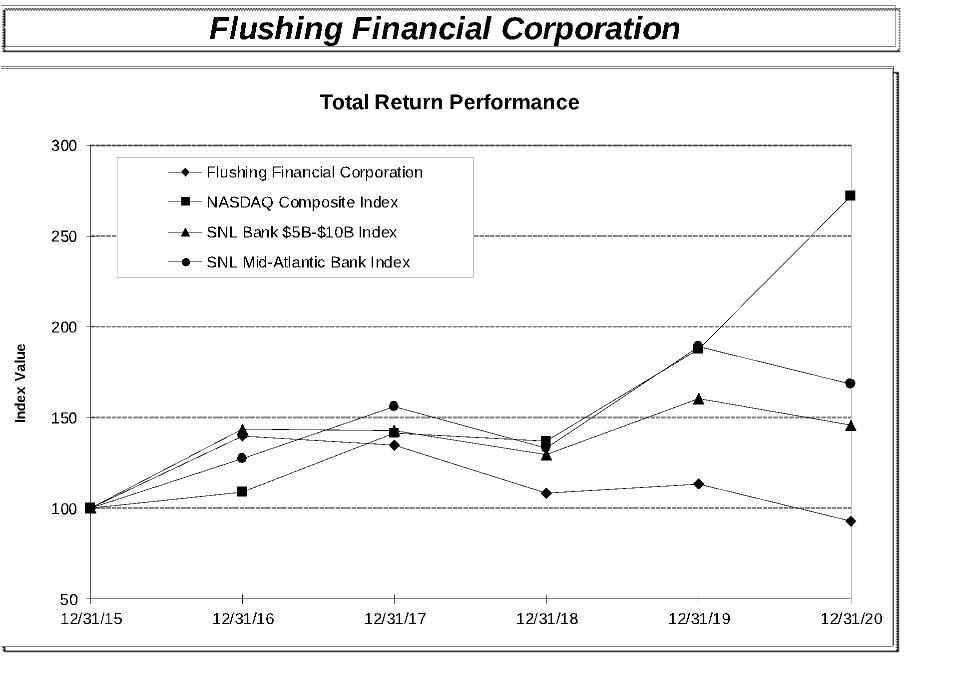Stock Performance Graph
The following graph shows a comparison of cumulative total stockholder return on the Company’s common stock since December 31, 20152018 with the cumulative total returns of a broad equity market index as well as comparative published industry indices. The broad equity market index chosen was the Nasdaq Composite. TheComposite and the comparative published industry indices chosenused were the SNL Bank $5 Billion to $10 Billion in AssetsS&P U.S. MidCap Banks Index and the SNLS&P U.S. BMI Banks - Mid-Atlantic BankRegion Index. The SNLS&P U.S. BMI Banks - Mid-Atlantic BankRegion Index was chosen for inclusion in the Company’s Stock Performance Graph because the Company believes it provides valuable comparative information reflecting the Company’s geographic peer group. The SNL Bank $5 Billion to $10 Billion in AssetsS&P U.S. MidCap Banks Index was chosen for inclusion in the Company’s Stock Performance Graph because it uses a broader group of banks and therefore more closely reflects the Company’s size. The Company believes that both geographic area and size are important factors in analyzing the Company’s performance against its peers. The graph below reflects historical performance only, which is not indicative of possible future performance of the common stock.


The total return assumes $100 invested on December 31, 20152018 and all dividends reinvested through the end of the Company’s fiscal year ended December 31, 2020.2023. The performance graph above is based upon closing prices on the trading date specified.
| | | �� | | | | | | | | | | | | | | | | | | | | | |
| | Period Ending | | Period Ending | ||||||||||||||||||||
Index |
| 12/31/15 |
| 12/31/16 |
| 12/31/17 |
| 12/31/18 |
| 12/31/19 |
| 12/31/20 |
| 12/31/18 |
| 12/31/19 |
| 12/31/20 |
| 12/31/21 |
| 12/31/22 |
| 12/31/23 |
Flushing Financial Corporation |
| 100.00 |
| 139.93 |
| 134.42 |
| 108.58 |
| 113.34 |
| 92.83 |
| 100.00 | | 104.39 | | 85.49 | | 129.36 | | 107.48 | | 97.23 |
NASDAQ Composite Index |
| 100.00 |
| 108.87 |
| 141.13 |
| 137.12 |
| 187.44 |
| 271.64 |
| 100.00 | | 136.69 | | 198.10 | | 242.03 | | 163.28 | | 236.17 |
SNL Bank $5B-$10B Index |
| 100.00 |
| 143.27 |
| 142.73 |
| 129.17 |
| 160.06 |
| 145.37 | ||||||||||||
SNL Mid-Atlantic Bank Index |
| 100.00 |
| 127.10 |
| 155.78 |
| 133.10 |
| 189.29 |
| 168.47 | ||||||||||||
S&P U.S. MidCap Banks Index |
| 100.00 | | 131.89 | | 130.44 | | 189.83 | | 139.58 | | 104.07 | ||||||||||||
S&P U.S. BMI Banks - Mid-Atlantic Region Index |
| 100.00 | | 142.19 | | 128.53 | | 162.33 | | 137.10 | | 166.23 | ||||||||||||
54